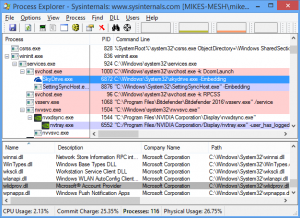

- PROCESS EXPLORER COMMAND LINE FOR MAC HOW TO
- PROCESS EXPLORER COMMAND LINE FOR MAC FULL
- PROCESS EXPLORER COMMAND LINE FOR MAC WINDOWS 10
- PROCESS EXPLORER COMMAND LINE FOR MAC CODE
- PROCESS EXPLORER COMMAND LINE FOR MAC DOWNLOAD
Run the following code in your PowerShell session when the Brave browser is running. PowerShell then uses Get-NetTCPConnection to find information about each network connection the brave process has open. For each instance of the brave process it finds, it uses that process’s ID ( $_.id) and passes it to Get-NetTCPConnection.
PROCESS EXPLORER COMMAND LINE FOR MAC FULL
To display a list of property aliases mapped to full property names, use the command Get-Process | Get-Member -MemberType 'AliasProperty'.īelow is another great example.


The working set consists of the pages of memory that were recently referenced by the process.
PROCESS EXPLORER COMMAND LINE FOR MAC WINDOWS 10
This article uses Windows 10 and Ubuntu 20.04 LTS, but any OS that PowerShell runs on will work.Related: Upgrading to PowerShell 7: A Walkthrough Although Windows PowerShell 5.1 is sufficient for most examples here, PowerShell 7.1 and greater is necessary for Linux support.Discovering Where a Process Binary Livesīefore going any further, below are the necessary prerequisites to follow along with the examples in this article.It's also been officially updated for Windows 11, whereas SuperF4 hasn't. ProcessKO is a good option for advanced users, as it offers extras like the ability to kill a specific process after a set time interval.

If none of the above options work for you, you'll find other third-party tools that can force-close Windows programs. Other Third-Party Apps for Force-Closing Programs Then simply press Win + Alt + Q to kill the current window.ĪutoHotkey is a powerful program that's capable of doing pretty much anything you dream up, so check out our AutoHotkey beginner's guide if you want to set up a more advanced script. Move the finished file into your Startup folder (enter shell:startup into the File Explorer address bar to get there) so it runs every time you log on.
PROCESS EXPLORER COMMAND LINE FOR MAC DOWNLOAD
You'll need to download AutoHotkey, then create a script with this line: #!Q::WinKill,A This is a little overkill if you don't use AutoHotkey for anything else, but with the program's power, you're sure to find other uses for it. You can also create a basic AutoHotkey script to force-close windows.
PROCESS EXPLORER COMMAND LINE FOR MAC HOW TO
How to Force-Close Programs With AutoHotkey If you're looking for an alternative way to close a program because the Task Manager won't work, see our guide on fixing the "Task Manager has been disabled" error.


 0 kommentar(er)
0 kommentar(er)
